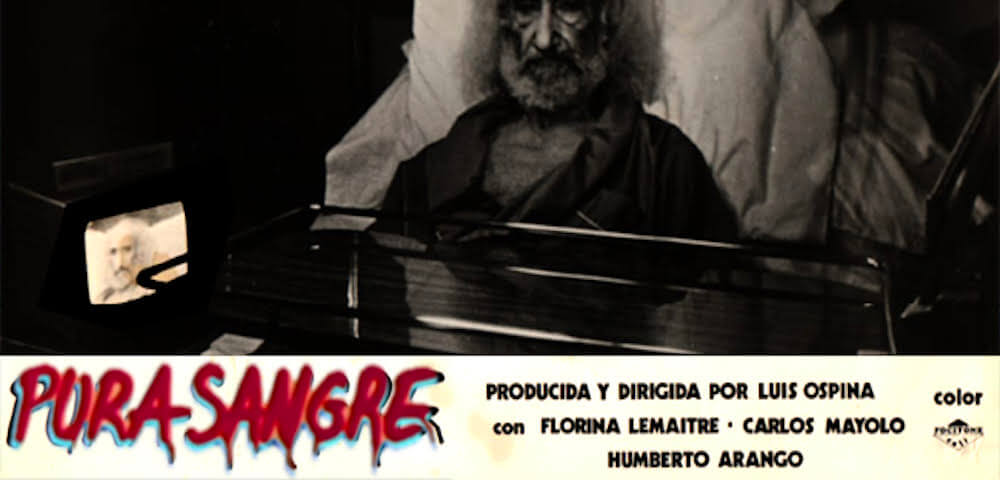PURA SANGRE
(PURE BLOOD)
dir. Luis Ospina, 1982
98 min. Colombia.
In Spanish with English subtitles.
ONE NIGHT ONLY!
In partnership with the Latin American Film Center (LAFC) as part of their Third Cinema series, Spectacle is thrilled to reprise the late Colombian maverick Luis Ospina’s groundbreaking debut feature PURA SANGRE (“pure blood”), followed by a conversation with actress, painter and art director Karen Lamassonne.
The first feature film produced by the storied Grupo de Cali – named for their hometown – PURA SANGRE follows a trio of health aides to a dying sugar magnate named Don Roberto who find themselves blackmailed into abducting and murdering children for the purposes of keeping him alive, one blood transfusion at a time. As writer Andres Caicedo referred to Cali as “a city that doesn’t open its doors to desperate men”, Ospina’s careful eye registers the mercenaries’ dispassionate crimes with surreal casualness. Filmmaker Carlos Mayolo (CARNE Y TU CARNE) stars as one of Don Roberto’s three contract killers, giving deadpan casualness to a day’s work committing one atrocity after another.
A cinephilic work par excellence, PURA SANGRE invites metatextual scrutiny across each of its cool-registered plotlines, as Don Roberto watches JOHNNY GUITAR and CITIZEN KANE from his deathbed. The conspiracy at its heart invites any number of analogies: in interviews Mayolo and Ospina both discussed the “monster of Mangones” terrorizing Cali growing up, a string of disappearances and murders of young boys that haunted a generation of neighborhood kids. Contemporaneously, Don Roberto’s empire finds itself in hock to sleazy drug dealers, widening the scope of PURA SANGRE’s design of tragedy. Ospina’s vision of evil can barely even be called “satiric” but nonetheless is, cutting both backwards and forwards in history.
“I can’t be objective about PURA SANGRE. I did the storyboards, I have this very tight bond with it. I don’t see its characters as horrible people, necessarily, but the story is indeed horrible. The movie is not bloody, because the blood is all contained in hypodermic needles, in bags. It was also a film financed by the government, so in a way it’s a reflection of them, an image they are exporting of Colombia, and it’s not great. But a lot of the film is based on incidents that really happened, even though it’s fiction. It is so much more real than a vampire film—but it’s also the traditional story of the vampire, who sucks the blood of the poor people. It’s also very Colombian. If an Argentine sees it, they’ll know it’s Colombian. And for a lot of people that was terrible. The story is especially awful for people who have children. I didn’t have children then; I have a son now. I didn’t show him PURA SANGRE until he had graduated high school, and he tells me he thought that was good.” – Karen Lamassonne
KAREN LAMASSONNE is a painter and video artist, born in New York in 1954 to a Colombian mother and Argentine father. and raised in a multi-cultural and multi-lingual environment, Lamassonne has lived and worked in the United States, Colombia, France, Germany and Italy. Her work is always autoreferential; a response to her environment and emotions in which eroticism is a silent participant. She began her artistic activities in Bogotá in 1974, where she forged relationships with local artists and galleries which stimulated her production. During the 1980´s she lived in Cali, a defining period for her career, where she bonded with the dynamic group of artists and filmmakers known as “The Grupo de Cali”. During this period she combined her cinematographic experience to create works in photography and video. At the same time she complemented her painting with Art Direction, Costume Design, Editing and Acting in different national and international productions. Her experience and drive have led to a multifaceted creative output across the disciplines of fine arts, design, film, theater and music. She lives and works in Atlanta, Georgia.
STEVE MACFARLANE is a filmmaker, programmer and writer based in Ridgewood, NY. He is an active volunteer at Spectacle, where he has curated screenings for over ten years, and has also presented movies at MoMA, the Smithsonian National Museum of African-American History and Culture (NMAAHC), Anthology Film Archives and other institutions. He has been at work on a monograph about Nancy Meyers since 2018.
Organized in collaboration with the Latin American Film Center, sponsored by the New York State Council on the Arts and the New York City Department of Cultural Affairs.

